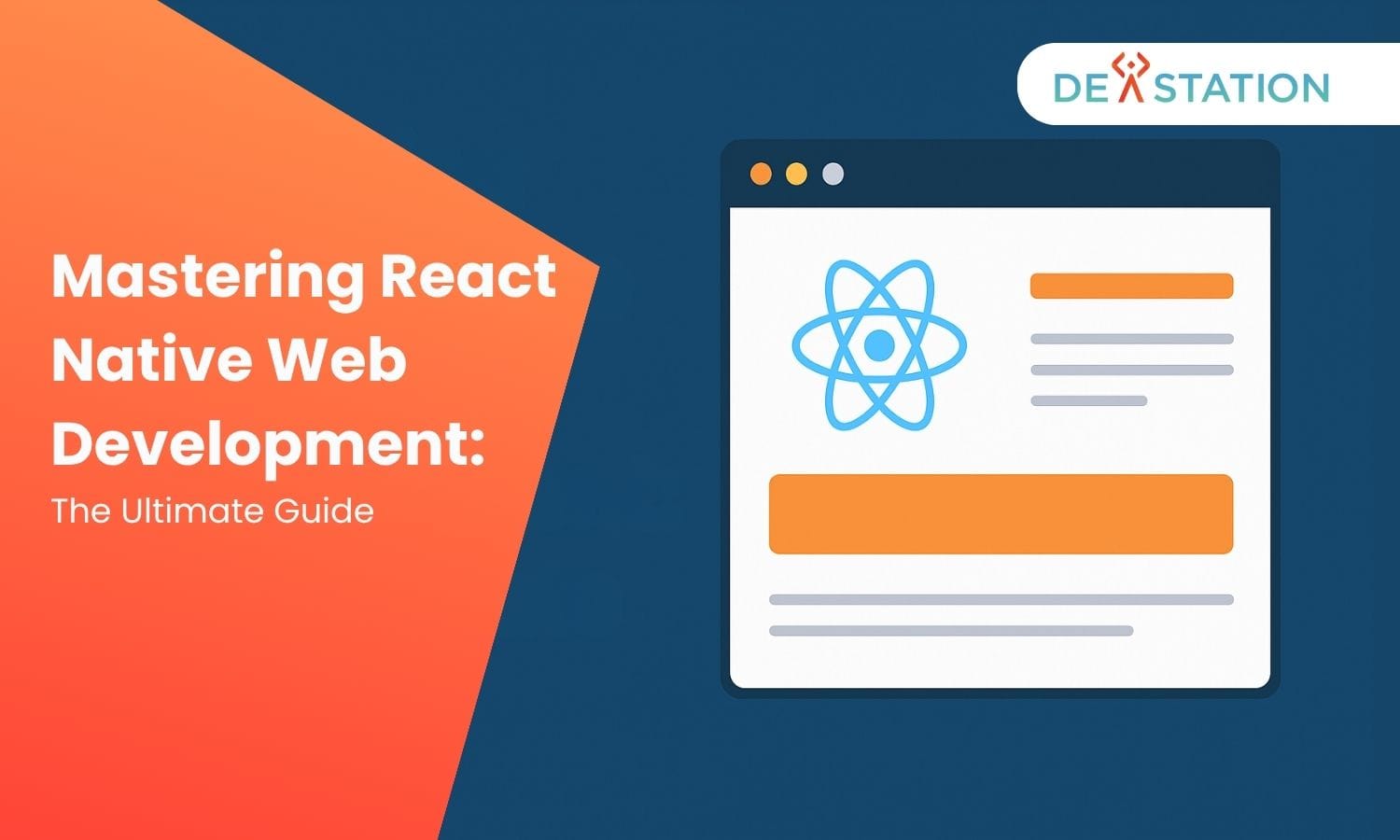What if you could build apps for mobile and browsers using one codebase? Modern teams face growing pressure to deliver consistent experiences across platforms without doubling their workload. This guide explores a framework that redefines cross-platform efficiency.
React Native for Web transforms how developers approach projects. Created as an open-source solution, it bridges mobile-first design with browser compatibility. Components built for Android or iOS automatically adapt to web standards like HTML and CSS. Companies like Uber and Major League Soccer use this strategy to maintain brand consistency while cutting production time.
The technology works by mapping mobile elements to web equivalents. A View component becomes a div tag, while Text translates to span. This atomic conversion preserves functionality across devices. Teams reuse logic and UI patterns instead of rewriting them for each platform.
Why does this matter for businesses? Unified codebases reduce maintenance costs and accelerate updates. Decision-makers gain flexibility to prioritize features rather than platform-specific fixes. The result: faster time-to-market and resources freed for innovation.
Contents
ToggleKey Takeaways
- Single codebase deployment across mobile and web platforms
- Component mapping ensures consistent UI behavior
- Trusted by industry leaders for production-level apps
- Reduces redundant coding efforts by 40-60%
- Simplifies updates through centralized logic
Understanding React Native for Web
Component mapping reshapes multi-platform development strategies. By translating mobile interfaces into browser-ready elements, teams eliminate redundant workflows while maintaining visual harmony. This approach turns platform-specific challenges into unified solutions.

The Evolution of Cross-Platform Development
Early solutions required separate codebases for each platform. Developers spent hours rewriting logic for iOS, Android, and browsers. Modern tools now automate component adaptation through intelligent translation layers.
Consider how native components transform during compilation:
| Mobile Element | Web Equivalent | Behavior Consistency |
|---|---|---|
| View | div | 98% |
| Text | span | 95% |
| Image | img | 90% |
How Mobile and Web Elements Interact
Package aliases act as traffic directors during builds. When targeting browsers, imports redirect to web-optimized versions. Mobile environments retain original implementations automatically.
The system uses React’s core APIs to construct DOM elements. This preserves development patterns teams already know. React.createElement becomes the bridge between native and web environments without requiring new skills.
The Evolution and Benefits of React Native Web Development
Adopting a unified codebase strategy reshapes how teams build for multiple platforms. Instead of managing separate projects for mobile and browsers, developers maintain one source of truth. This approach streamlines workflows while ensuring feature parity across devices.

Why Use a Unified Codebase?
Centralized code eliminates platform-specific silos. Teams write business logic once, then deploy it everywhere. Updates propagate instantly across iOS, Android, and web interfaces.
Consider these efficiency gains:
- 60% faster feature deployment
- 45% reduction in debugging time
- Single styling system using CSS-in-JS
Key Advantages for Modern Apps
Pre-built component libraries accelerate production timelines. Popular UI kits work seamlessly across platforms, maintaining visual consistency. Expo’s zero-configuration setup lets teams enable browser support in minutes.
| Approach | Code Reuse | Update Time | Platform Expansion |
|---|---|---|---|
| Traditional Multi-Platform | 30-40% | Weeks | Complex |
| Unified Codebase | 85-95% | Hours | One-click |
This method future-proofs projects. Adding desktop support later requires minimal adjustments. Decision-makers reallocate saved resources toward user experience improvements rather than redundant coding.
Setting Up Your Development Environment
The first critical choice in cross-platform projects involves tool selection. Teams must balance speed with customization when configuring their workflow foundation. Two distinct paths emerge: streamlined platforms versus hands-on control.
Choosing Between Expo and React Native CLI
Expo simplifies initial setup with pre-configured tools. Its universal SDK handles browser compatibility automatically. Developers gain instant access to cross-platform APIs and optimized builds without wrestling with configurations.
This option shines for prototypes or teams prioritizing rapid iteration. Updates deploy simultaneously across iOS, Android, and browser targets. Expo manages dependencies behind the scenes, letting creators focus on features.
The manual CLI approach demands deeper technical involvement. Developers install react-native-web and configure Webpack themselves. While requiring more setup time, this method offers granular control over build processes and dependency trees.
| Factor | Expo | CLI |
|---|---|---|
| Configuration Time | Minutes | Hours |
| Customization | Limited | Full |
| Ideal For | Startups/Prototypes | Enterprise Systems |
Enterprise teams often prefer CLI for complex integrations. Custom webpack configurations enable advanced optimizations and legacy system compatibility. However, maintenance demands increase with this flexibility.
Navigating React Native CLI and Expo for Web
Choosing the right tools determines how efficiently teams adapt code for multiple platforms. Two distinct workflows emerge when building cross-environment projects: streamlined automation versus manual control. This section compares setup processes to match organizational priorities.
Initial Project Setup and Installation
Expo accelerates prototyping with preconfigured templates. Run npx create-expo-app ReactNativeWebDemo to generate starter files. Essential web packages install via npx expo install react-dom react-native-web @expo/webpack-config, enabling browser compatibility in minutes.
The manual CLI method offers deeper customization. Initialize projects with npx react-native init ReactNativeWebDemo, then add react-native-web and related dependencies. Developers create separate entry files for mobile and browser targets to manage platform-specific logic.
| Approach | Setup Time | Key Commands |
|---|---|---|
| Expo | 5 minutes | create-expo-app, expo install |
| CLI | 30+ minutes | react-native init, manual dependency setup |
Configuring the Build for Web Compatibility
Expo handles build configurations automatically. Running npm run web triggers Webpack optimizations through @expo/webpack-config. This package resolves module aliases and applies performance enhancements without manual intervention.
CLI projects require explicit AppRegistry configuration. Developers define web entry points in src/index.js and modify index.native.js for mobile. The command chain AppRegistry.runApplication bridges native components with DOM elements during compilation.
| Task | Expo Solution | CLI Solution |
|---|---|---|
| Entry Points | Auto-generated | Manual file creation |
| Build Optimization | Pre-configured | Custom Webpack rules |
Integrating React Native Components into Web Apps
Cross-platform teams achieve visual harmony through precise element translation. The framework automatically converts mobile-first building blocks into browser-ready code while preserving interaction logic.
Mapping Native Components to HTML Elements
Core mobile elements transform during compilation through predefined rules. A View container becomes a div tag with flexbox styling. Text components render as span elements, inheriting font properties from global CSS.
Interactive elements adapt to browser capabilities. TouchableOpacity translates to clickable button tags with hover states. ScrollView containers generate div elements with overflow-y: scroll styling for vertical navigation.
| Mobile Component | HTML Equivalent | Styling Method |
|---|---|---|
| View | div | Flexbox CSS |
| Text | span | Font inheritance |
| Image | img | Object-fit CSS |
| Touchable | button | Pointer events |
Styling systems maintain pixel-perfect consistency across platforms. JavaScript StyleSheet objects compile into CSS-in-JS rules during builds. This process preserves margins, padding, and flex properties without manual adjustments.
Event handling bridges mobile and browser interactions. Touch gestures become click events, while swipe actions translate to horizontal scroll behaviors. Developers maintain a single event API for all platforms, reducing conditional logic.
react native web development: Implementation Strategies
How do teams structure projects to maximize code reuse without sacrificing platform performance? Strategic planning separates successful implementations from fragmented efforts. Start by defining shared components and platform-specific overrides early in the architecture phase.
Step-by-Step Project Configuration
Begin with Expo or CLI based on project complexity. For Expo workflows, enable web support using expo install react-dom react-native-web. Create separate entry files for mobile and browser targets to handle environment-specific logic.
Organize code into three directories:
- Shared: Reusable components and business logic
- Mobile: Native module integrations
- Web: SEO meta tags and responsive layouts
Leveraging Community Resources
The React Native Directory identifies libraries with built-in browser compatibility. UI kits like Elements and Paper offer cross-platform components that adapt styling through CSS-in-JS. Integrate static site generators like Gatsby for marketing pages while maintaining core app logic in shared modules.
| Tool | Use Case | Web Support |
|---|---|---|
| NativeBase | Unified UI Components | Full |
| Next.js | Server-Side Rendering | Partial |
| React Navigation | Routing Solutions | Conditional |
Evaluate third-party packages using three criteria: maintenance frequency, dependency tree size, and platform exception handling. Prioritize solutions with active GitHub communities and clear documentation for long-term stability.
Mastering Styling and Layout Challenges
How do you maintain visual harmony when designs must adapt to mobile screens and desktop monitors? The answer lies in balancing platform-specific styling rules with shared design systems. This balance becomes critical when translating compact mobile interfaces into expansive browser layouts.
CSS-in-JS: The Universal Styling Bridge
React Native for Web extends its StyleSheet API to browsers, letting teams apply identical JavaScript styling objects across platforms. CSS-in-JS compiles these rules into optimized browser CSS during builds. Developers write once, then deploy styles that automatically adjust for pixel density and viewport sizes.
Flexbox behaviors often differ between environments. Mobile-first layouts might collapse on wide screens without media queries. Strategic use of percentage-based widths and min/max constraints prevents elements from stretching unnaturally on desktops.
Cross-Platform Consistency Tactics
Text rendering poses unique challenges. Font sizes that look crisp on mobile may appear blurry in browsers. Define typography scales using relative units like rem, then fine-tune with platform-specific overrides. Touch interactions require similar adaptations—hover states enhance web usability but don’t exist on mobile.
Three strategies ensure reliability:
- Test layouts on emulators and physical devices
- Use conditional styling for critical platform differences
- Establish baseline CSS reset files for web targets
Teams that master these techniques cut styling-related bugs by 70% while accelerating design iterations. The result? Interfaces that feel native everywhere—without rebuilding from scratch.





